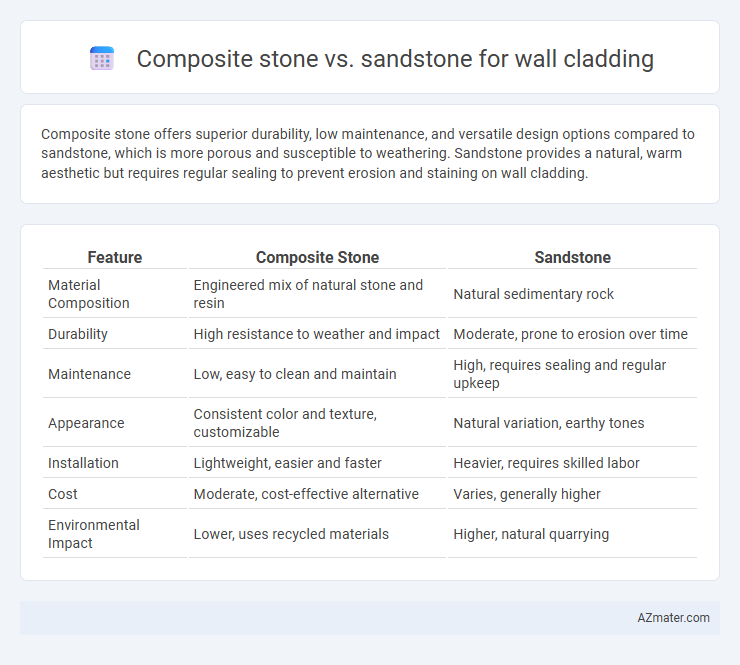Composite stone offers superior durability, low maintenance, and versatile design options compared to sandstone, which is more porous and susceptible to weathering. Sandstone provides a natural, warm aesthetic but requires regular sealing to prevent erosion and staining on wall cladding.
Table of Comparison
| Feature | Composite Stone | Sandstone |
|---|---|---|
| Material Composition | Engineered mix of natural stone and resin | Natural sedimentary rock |
| Durability | High resistance to weather and impact | Moderate, prone to erosion over time |
| Maintenance | Low, easy to clean and maintain | High, requires sealing and regular upkeep |
| Appearance | Consistent color and texture, customizable | Natural variation, earthy tones |
| Installation | Lightweight, easier and faster | Heavier, requires skilled labor |
| Cost | Moderate, cost-effective alternative | Varies, generally higher |
| Environmental Impact | Lower, uses recycled materials | Higher, natural quarrying |
Introduction to Wall Cladding Materials
Composite stone offers enhanced durability and low maintenance compared to natural sandstone, making it a preferred choice for modern wall cladding projects. Sandstone, valued for its natural texture and earthy tones, provides excellent weather resistance but requires regular sealing to prevent erosion and discoloration. Selecting between composite stone and sandstone depends on factors such as budget, aesthetic preference, and long-term performance requirements for exterior wall cladding.
What is Composite Stone?
Composite stone for wall cladding is an engineered material made by combining crushed natural stone with resin and pigments to create durable, lightweight panels that mimic the appearance of natural stone. It offers enhanced resistance to weathering, consistent color, and easier installation compared to traditional sandstone, which is a sedimentary rock known for its natural texture and variable strength. Composite stone panels provide a versatile and low-maintenance solution ideal for both interior and exterior wall cladding applications.
Understanding Sandstone for Cladding
Sandstone for wall cladding offers natural durability and unique textures, making it a favored choice for both exterior and interior applications. Its porous structure allows for breathability, reducing moisture retention and enhancing weather resistance over time. Proper sealing and maintenance are essential to preserve the stone's aesthetic appeal and structural integrity against environmental elements.
Aesthetic Differences: Composite Stone vs Sandstone
Composite stone offers a consistent texture and color palette, providing a sleek, modern aesthetic ideal for contemporary wall cladding designs. Sandstone features natural variations in hue and grain, lending a rustic and organic appearance that enhances traditional or earthy architectural styles. The choice between composite stone and sandstone influences the visual impact, with composite stone delivering uniformity and sandstone showcasing unique natural patterns.
Durability and Longevity Comparison
Composite stone offers superior durability and longevity compared to sandstone for wall cladding due to its engineered composition, which resists weathering, chipping, and freezing better than natural sandstone. Sandstone, while aesthetically natural and textured, is more porous and susceptible to erosion, staining, and structural degradation over time, especially in harsh climates. Choosing composite stone extends maintenance intervals and enhances long-term appearance retention, making it a more cost-effective solution for durable exterior wall cladding.
Maintenance Requirements
Composite stone cladding requires minimal maintenance compared to sandstone, as it is resistant to staining, weathering, and color fading. Sandstone, a natural porous material, demands regular sealing and cleaning to prevent moisture absorption and surface erosion over time. Choosing composite stone reduces long-term upkeep costs and ensures a durable, low-maintenance facade for wall cladding applications.
Cost Considerations
Composite stone typically offers a more cost-effective solution for wall cladding compared to natural sandstone due to lower material and installation expenses. Sandstone's price fluctuates based on quality, origin, and finish, often making it a premium choice with higher maintenance costs over time. Budget-conscious projects frequently prefer composite stone for its durability and affordability without compromising aesthetic appeal.
Environmental Impact and Sustainability
Composite stone wall cladding often incorporates recycled materials and requires less quarrying, reducing environmental degradation and resource depletion compared to natural sandstone. Sandstone extraction involves intensive mining activities leading to habitat disruption, higher carbon emissions, and substantial water usage during processing. Choosing composite stone enhances sustainability through lower embodied energy and extended material lifespan, aligning with eco-friendly building practices.
Installation Ease and Versatility
Composite stone offers superior installation ease compared to sandstone due to its lightweight nature and pre-fabricated panels that reduce labor time and complexity. Sandstone, while durable, requires meticulous cutting and skilled craftsmanship, making it less versatile in application and more time-consuming to install. The versatility of composite stone allows it to adapt to various wall shapes and designs, providing more flexibility in both interior and exterior cladding projects.
Which Wall Cladding is Best for Your Project?
Composite stone offers superior durability, low maintenance, and a wide range of colors and textures, making it ideal for modern wall cladding projects requiring long-lasting performance. Sandstone provides a natural, timeless aesthetic with excellent breathability but requires regular sealing to prevent weathering and erosion. Choosing the best wall cladding depends on project priorities such as maintenance, appearance, and environmental conditions.

Infographic: Composite stone vs Sandstone for Wall Cladding
 azmater.com
azmater.com